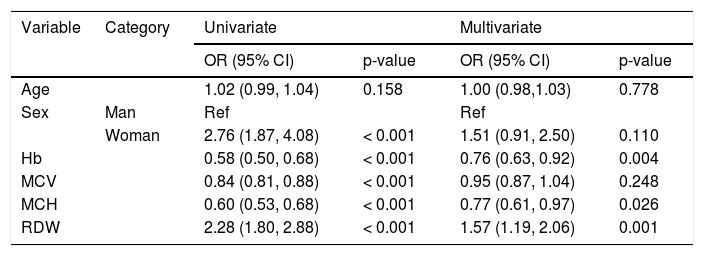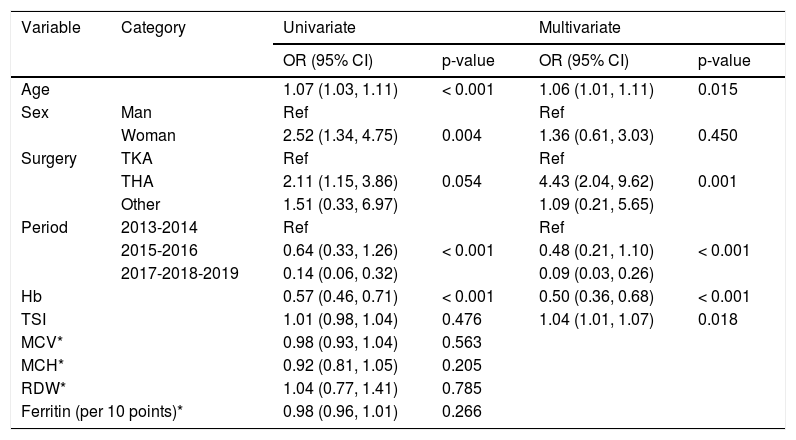anemia and iron deficiency predispose to an increased risk of transfusion with a consequent increase in morbidity and mortality. The study analyzes whether blood cell count parameters in addition to detecting anemia can predict iron deficiency and/or transfusional risk in patients undergoing mostly to scheduled primary hip and knee arthroplasty.
ObjectiveTo analyze how blood cell count parameters predict iron deficiency and/or transfusional risk in patients undergoing programmed arthroplasty.
Material and methodsThe analytical and transfusion results of 522 patients undergoing arthroplasty have been prospectively collected between 2013 and 2019 and the discriminative and predictive capacity of the basic parameters of the red cells have been analyzed; hemoglobin (Hb), mean cell volume, mean cell hemoglobin (HCM) and red blood cell distribution width (RDW) for the identification of presurgical iron deficiency and postsurgical transfusion.
ResultsAnaemia was detected in 6.6%, “suboptim” Hb (<13 g/dL) in 14.5% and iron deficiency in 32.4%. Anemia detects only 13.8% of ID.
After logistic regression analysis, the multivariate model significantly related Hb (p = .004), mean corpuscular hemoglobin (MCH) (p = .026), and the red cell distribution width (RDW) (p = .001) with ID; but mean corpuscular volume (MCV) is not significant.
Hb, age and transferrin saturation index have been the only risk factors for transfusional risk of the parameters analyzed.
ConclusionsThe hemogram contains parameters that correlate with iron deficiency, however, mean cell volume, so widely used for the orientation of iron deficiency, is not valid as a discriminator of iron deficiency in this group of patients.
Low Hb and transferrin saturation index are modifiable predictors for transfusion risk.
La anemia y la ferropenia predisponen a un mayor riesgo de transfusión con su consiguiente aumento de morbimortalidad. El estudio analiza si los parámetros básicos del hemograma además de detectar la anemia pueden predecir el déficit de hierro y/o la transfusión en los pacientes sometidos a artroplastia primaria total de cadera y rodilla programada.
Pacientes y métodosSe han recogido prospectivamente los resultados analíticos y de actividad transfusional de 522 pacientes intervenidos de artroplastia entre los años 2013 y 2019 y se ha analizado la capacidad discriminativa y predictiva de los parámetros básicos de la serie roja; hemoglobina (Hb), volumen corpuscular medio, hemoglobina corpuscular media y ancho de distribución eritrocitario para la identificación del déficit de hierro preoperatorio y la transfusión posquirúrgica.
ResultadosEn el preoperatorio de pacientes pendientes de artroplastia se detecta anemia en el 6,6%; Hb «subóptima» (<13 g/dL) en 14,5%; y ferropenia en el 32,4%. Solo un 13,8% de los déficits de hierro tienen anemia.
Tras los análisis de regresión logística, el modelo multivariante relaciona significativamente la Hb (p = 0,004), la hemoglobina corpuscular media (p = 0,026) y el ancho de distribución eritrocitario (p = 0,001) con el déficit de hierro. Sin embargo, el volumen corpuscular medio no tiene significación.
La Hb, la edad y el índice de saturación de transferrina han resultado los únicos factores de riesgo para la transfusión, de los parámetros analizados.
ConclusionesEl hemograma contiene parámetros que se correlacionan con la ferropenia, sin embargo el volumen corpuscular medio, tan ampliamente utilizado para la orientación de ferropenia, no es válido como discriminativo de ferropenia en este grupo de pacientes.
La Hb y el índice de saturación de transferrina bajos son factores de riesgo modificables predictores de transfusión.












